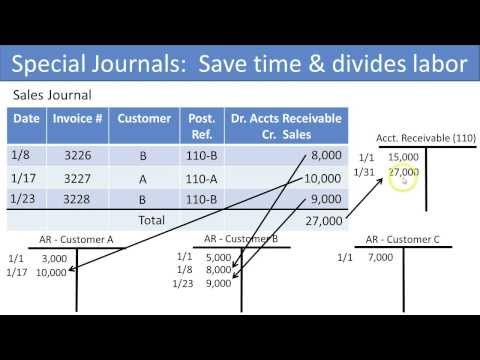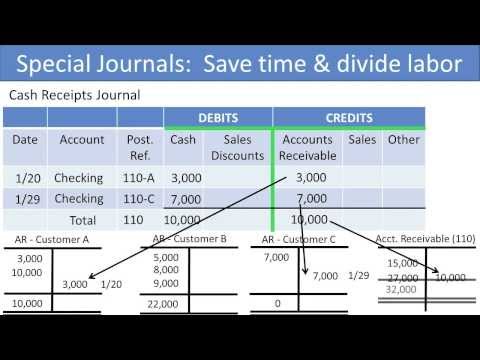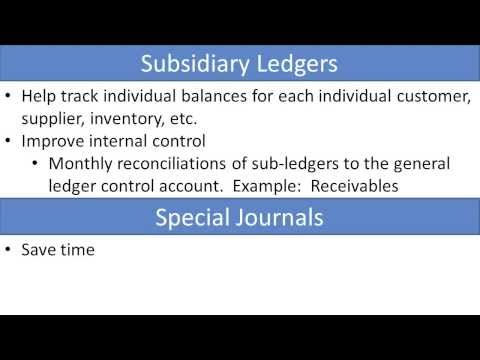8.2: Special Journals
- Page ID
- 26224
Look at the following transactions of Fooz Ball Town:
- July 5 Sold $5,000 of merchandise inventory, terms 1/15, n 30, FOB Destination with a cost of goods sold of $3,000 to Robby Red.
- July 6 Paid shipping cost of $200 on merchandise sold on July 5.
- July 10 Sold $1,500 of merchandise inventory for cash, FOB Shipping Point, with a cost of goods sold of $1,000.
- July 12 Purchased $10,000 of merchandise inventory, terms 2/15, n 45, FOB Destination from Gus Grass.
- July 15 Received payment from Robby Red from July 5 sale less the discount.
- July 16 Returned $2,500 of merchandise damaged in shipment from July 12 purchase.
- July 20 Paid the utility bill for $300.
- July 25 Paid for the July 15 purchase less the return and discount.
- July 30 Sold $7,000 of merchandise inventory, terms 1/15, n 30, FOB Shipping point with cost of goods sold $5,000 to Bobby Blue.
You can see how these journal entries (using the perpetual inventory method) would be recorded in the general ledger as by clicking fooz ball town to save space.
Note: The entries would be slightly different under the periodic inventory method as cost of goods sold and merchandise inventory are not updated until the end of the period instead of with each sale or purchase.
The list of entries for these 9 transactions is long…can you imagine what it would look like when a company has hundreds of transactions a day? It will be overwhelming so there needs to be a better way. Special journals are a quicker and more efficient way to enter transactions. Remember, we have 5 special journals:
- a sales journal to record ALL CREDIT SALES
- a purchases journal to record ALL CREDIT PURCHASES
- a cash receipts journal to record ALL CASH RECEIPTS
- a cash disbursements journal to record ALL CASH PAYMENTS; and
- a general journal to record adjusting and closing entries and any other entries that do not fit in one of the special journals.
Now we will classify Fooz Ball Town’s transactions into the proper special journals:
| Date | Transaction Summary | Special Journal |
| July 5 | Sold to Robby Red on credit. | Sales Journal |
| July 6 | Paid shipping cost. | Cash Disbursements Journal |
| July 10 | Sold inventory for cash. | Cash Receipts Journal |
| July 12 | Purchased inventory on credit. | Purchases Journal |
| July 15 | Received payment from Robby Red. | Cash Receipts Journal |
| July 16 | Returned damaged merchandise to supplier . | General Journal |
| July 20 | Paid utility bill. | Cash Disbursements Journal |
| July 25 | Paid for July 15 purchase. | Cash Disbursements Journal |
| July 30 | Sold to Bobby Blue on credit. | Sales Journal |
The July 10 sales is not recorded in the sales journal — why not? It was a cash sale and not on credit. The discussion continues by looking at each special journal in detail.
Sales Journal
The sales journal is used to record all sales on credit. This means the customer has not paid but we will receive payment in the future. The video shows an example of a sales journal under the periodic inventory method:
Under the perpetual inventory system, the Sales Journal would have another column to show Debit to Cost of Goods Sold and a Credit to Inventory. For Fooz Ball Town, we identified the following transactions for the sales journal:
- July 5 Sold $5,000 of merchandise inventory, terms 1/15, n 30, FOB Destination with a cost of goods sold of $3,000 to Robby Red.
- July 30 Sold $7,000 of merchandise inventory, terms 1/15, n 30, FOB Shipping point with cost of goods sold $5,000 to Bobby Blue.
These entries would be recorded in the sales journal (instead of general journal entries) as:
| Sales Journal | |||
| Date | Customer | DR Accounts Receivable | DR Cost of goods sold |
| CR Sales | CR Inventory | ||
| July 5 | Robby Red | $5,000 | $3,000 |
| July 30 | Bobby Blue | 7,000 | 5,000 |
| TOTALS | $12,000 | $8,000 | |
The subsidiary (customer) ledgers would be updated daily but at the end of the period, the TOTALS only would be recorded in posted directly into the accounts listed with no journal entry necessary.
Cash Receipts Journal
The cash receipts journal is used to record all receipts of cash for any reason. Anytime money comes into the company, the cash receipts journal should be used.
The cash receipts journal, under the perpetual inventory would, would also contain a column to Debit cost of goods sold and Credit inventory used for any cash sales. For Fooz Ball Town, we identified two transactions for the cash receipts journal:
- July 10 Sold $1,500 of merchandise inventory for cash, FOB Shipping Point, with a cost of goods sold of $1,000.
- July 15 Received payment from Robby Red from $5,000 sale less the 1% discount.
The cash receipts journal for these transactions would be:
| Cash Receipts Journal | ||||||
| Date | Account | DR Cash | DR Sales | CR Accounts | CR Sales | DR Cost of goods Sold |
| Discounts | Receivable | CR Inventory | ||||
| July 10 | Checking | 1,500 | 1,500 | 1,000 | ||
| July 15 | Checking | 4,950 | 50 | 5,000 | ||
| TOTALS | 6,450 | 50 | 5,000 | 1,500 | 1,000 | |
At the end of the period, the TOTALS only would be recorded in posted directly into the accounts listed with no journal entry necessary.
Purchase Journal
The purchases journal is used to record all purchases on credit. This means purchases we have not paid for but will pay for in the future. There was one transaction identified for the purchase journal for Fooz Ball Town:
- July 12 Purchased $10,000 of merchandise inventory, terms 2/15, n 45, FOB Destination from Gus Grass.
This would be record in a purchases journal (under the perpetual inventory system as):
| Purchases Journal | ||
| Date | Vendor | DR Merchandise Inventory |
| CR Accounts Payable | ||
| July 12 | Gus Grass | 10,000 |
| TOTALS | 10,000 | |
The purchase from Gus Grass would be recorded in the accounts payable subsidiary ledger and the total would be recorded at the end on the period by posting directly to merchandise inventory and accounts payable.
This video demonstrates the purchase journal and cash disbursement journal:
Cash Disbursement Journal
The cash disbursement journal is used to record all payments of cash regardless of the reason. Anytime cash leaves the company, it should be recorded in the cash disbursement journal. We identified these transaction from Fooz Ball Town for the cash disbursement journal:
- July 6 Paid shipping cost of $200 on merchandise sold on July 5.
- July 20 Paid the utility bill for $300.
- July 25 Paid for the July 15 purchase from Gus Grass of $10,000 less the 2% discount and $2,500 return.
These entries would be recorded into a cash disbursement journal (under the perpetual inventory method) as:
| Cash Disbursement Journal | ||||||
| Date | Check # | Account | DR Accts Payable | DR Other | CR Mdse Inventory | CR Cash |
| July 6 | Merchandise Inventory | 200 | 200 | |||
| July 20 | Utilities Expense | $300 | $300 | |||
| July 25 | Gus Grass | 7,500 | 150 | 7,350 | ||
| TOTALS | $7,500 | $300 | $150 | $7,650 | ||
At the end of the period, we would post the totals of $7,650 credit to cash, the $7,500 debit to accounts payable, and the $150 credit to merchandise inventory. The DR (debit) Other column would be handled a little differently as you need to look to the account column to find out where these individual amounts should be posted. In this case, we would post a $200 debit to merchandise inventory and a $300 debit to utility expense. Under the periodic inventory method, the July 6 shipping costs would go to a Transportation In account and the July 25 discount would go to Purchases Discounts.
General Journal
When using special journals, the general journal is used to record all adjusting entries, closing entries and anything else that doesn’t fit into the other special journals. An example of this would be any returns or allowances coming from either the sales or purchase side. For Fooz Ball Town, there is one transaction for the general journal:
- July 16 Returned $2,500 of merchandise damaged in shipment from July 12 purchase.
This journal entry is recorded, under the perpetual inventory method as:
| Date | Account | Debit | Credit |
| July 16 | Accounts Payable | 2,500 | |
| Merchandise Inventory | 2,500 |
This entry would then be posted to the accounts payable and merchandise inventory accounts both for $2,500. Under the periodic inventory method, the credit would be to Purchase Returns and Allowances.
- Subsidiary Ledgers and Special Journals: Slide 7. Authored by: Kevin Kimball. Located at: youtu.be/IJKK_qtq-Ec. License: All Rights Reserved. License Terms: Standard YouTube License
- Subsidiary Ledgers and Special Journals: Slide 8. Authored by: Kevin Kimball. Located at: youtu.be/uxT1UxD-6w4. License: All Rights Reserved. License Terms: Standard YouTube License
- Subsidiary Ledgers and Special Journals: Slide 9-11. Authored by: Kevin Kimball. Located at: youtu.be/64vQGe8i74U. License: All Rights Reserved. License Terms: Standard YouTube License




